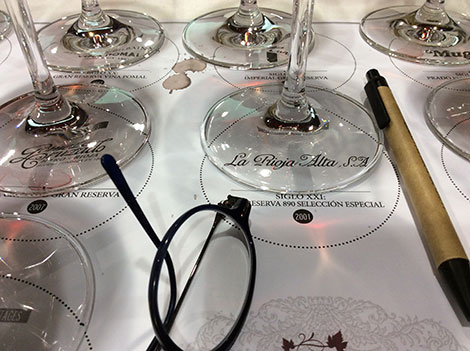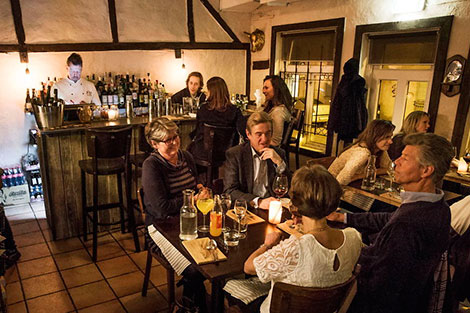Ramiro Ibáñez brings soils and terroir into Sherry country
The background photograph and nickname of Ramiro Ibáñez’s new Twitter account (@albarizatorio) are a telltale of the interests of this well-travelled Sanlúcar winemaker with experience in Australia and Bordeaux.
Albariza, the white chalky soil which is the sole element that has always been part of the history of the Sherry Triangle, is the starting point for Ramiro. Albariza acts as the backbone of his wines, which aim to express terroir and the personality of the pago (vineyard) against the biological aromas and flavours usually found in many of the region’s manzanillas and finos.
“Many wines go on sale when the flor (the layer of yeast) is at its peak, after three or four years aging, and it masks mostos (musts) of lesser quality. I’m much more interested in extracting terroir aromas in a sobretabla wine (a young wine which has completed fermentation) than to stop right when the flor is at its best”, says Ramiro.
Such a penchant for shaping young wines based on soils, locations, vintages and ancient varieties instead of caving in to the dictates of flor has pushed Ramiro to make wines outside the umbrella of the region’s regulatory body. Under such circumstances, he is forced to label his bottles as table wine, but he is unfazed. “The only thing I’m worried about is that the few growers who still tend these old vines might be tempted to pull them out if they cannot maintain them”.
The Sherry Triangle, from end to end
His Pitijopos series, as dragonflies are called in Sanlúcar, is a practical study of soils and locations in the Sherry Triangle. The six mostos of this “Volume 1: From North to South”, of which he has made 100 boxes (€60 for the series at Taberna der Guerrita in Sanlúcar and in Cuatrogatos Wine Club) have all fermented in casks under the same conditions in order to avoid any winemaking differences.
The singularity lies in the albariza soils, selected from six pagos found on a 50km strip stretching north to south and 25km from east to west. The differences in style are evident; for example, the wine from Macharnudo in Jerez (#5 in the series) that we tasted at A Emoción dos Viños in Tui has more body and concentration than the one from Chiclana (#6), with noticeable eucalyptus notes, which comes from an area where ripening times are slower and take longer than in Jerez. The second volume will be released “soon” under the name “Sanlúcar: Guadalquivir vs Atlantic” with a third soil challenge under way: albariza vs clay and sand.
Ube, another of his artisan projects, features old Palomino vines. They are old clones found in Pago Carrascal in Sanlúcar, so small percentages of old varieties such as Palomino de Jerez and Palomino Pelusón are part of the mix. Ube “has scars because it is badly treated on purpose”, says Ramiro. Fermented in old manzanilla casks for a year without flor, this wine is all about soils, vineyard and tradition. The 2014 vintage, with barely 400 bottles, is due to be released in December and despite its price tag (around €25), Ramiro has no trouble selling it.
New winery in Sanlúcar’s Bajo de Guía
This 2015 vintage is the first to be vinified at Cota 45, his new winery in Bajo de Guía, a bustling area on the shores of the Guadalquivir river. Despite its meagre 60 square meters, it has gorgeous views of Doñana National Park —a very special place for Ramiro, who grew up there given that his family where forest guards. No doubt many cathedral-like wineries in Sanlúcar would wish to enjoy such vistas.
Cota 45 is his “albarizatorio”, an old boat repair workshop which Ramiro has revamped to tread grapes and to store 25 casks lying over ostionera stones, a local porous rock traditionally found in wineries in Sanlúcar. Two of these vessels are chestnut butts, filled with vermouth and co-owned with friends Rayco Fernández, a vermouth expert from the Canary Islands, and Armando Guerra, the man behind Taberna der Guerrita and a firm advocate of the wines from the Sherry Triangle.
“There’s stuff here that is experimental but if people want to buy it, that’s great for me”, explains Ramiro, who makes a living working as a consultant for several wineries in the Triangle (Primitivo Collantes in Chiclana, Bodegas Piñero and La Callejuela de Sanlúcar, where it makes an intriguing vintage manzanilla). “The wines I’ve got here [at Cota 45] are unprofitable; I have to pick the grapes, pay for the diesel, the bottles, the labels… but I’m not complaining; I make enough to pay for the winery’s expenses”.
His PX, with 1,500 bottles of the 2014 vintage in the market, is Ramiro’s lesser known wine. It is called Pandorga, a word which means kite in Sanlúcar, and is made with grapes from Pago Carrascal which are fermented and partially dehydrated in the sun to concentrate their sugars —the old-fashioned way to get a concentrated wine with good acidity and white fruit notes.
Manifiesto 119
Encrucijado (around €16) is also a member of the Cota 45 family. An experimental vintage wine, it is made with six native varieties (Palomino, and small percentages of Mantúo de Pilas, Mantúo Castellano, Perruno, Cañocazo and Beba). These rare grapes almost disappeared due to the prevalence of Palomino Fino but were usually part of the blend in old Palo Cortado styles given their high malic acid levels which helped to give creaminess to the wines.
This Encrucijado ferments spontaneously in the cask, where it is biologically aged for 10 months with an extra 10 months of oxidative aging. It is then bottled unfortified, with 15.5% of alcohol —just on the moment when it is classified as Palo Cortado, hence its name (crossroad).
As the rest of his wines, there are only 685 half-litre bottles of Encrucijado 2012. It is just a rarity but a hugely interesting one given that it opens up a fascinating road towards new ways of making wines in the Sherry Triangle.
Ramiro Ibáñez is not alone in his quest to bring back avant garde trends from the past. It might be that these young winemakers have discovered the virtues of what they have at home after returning from their travels, but the fact is that both Ramiro and others in the wine trade are shaking things up in the Sherry Triangle.
The icing on the cake of Armando Guerra’s acclaimed Summer Tastings at his Taberna in Sanlúcar was the presentation of Manifesto 119, a new group formed by winemakers such as Ramiro and producers from Sanlúcar, Jerez, El Puerto and Chiclana who, as told by blog Cosas de Comé (in Spanish), have joined forces to champion the wines of Cádiz. No doubt albariza is the key element in the foundations of this new adventure.

Yolanda Ortiz de Arri
A journalist with over 25 years' experience in national and international media. WSET3, wine educator and translator
Spanish wines gain ground in Oslo
NEWSLETTER
Join our community of Spanish wine lovers






